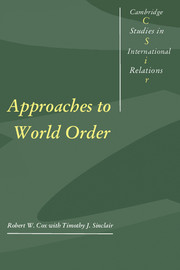Book contents
- Frontmatter
- Contents
- Preface
- Acknowledgements
- Part I Overviews
- Part II Theory
- 3 The idea of international labor regulation (1953)
- 4 Realism, positivism, and historicism (1985)
- 5 On thinking about future world order (1976)
- 6 Social forces, states, and world orders: beyond international relations theory (1981)
- 7 Gramsci, hegemony, and international relations: an essay in method (1983)
- 8 Towards a posthegemonic conceptualization of world order: reflections on the relevancy of Ibn Khaldun (1992)
- 9 “Take six eggs”: theory, finance, and the real economy in the work of Susan Strange (1992)
- Part III Interpretations
- Part IV Multilateralism
- Complete bibliography of works by Robert W. Cox to 1995
- Index of names
- Index of subjects
- CAMBRIDGE STUDIES IN INTERNATIONAL RELATIONS
3 - The idea of international labor regulation (1953)
Published online by Cambridge University Press: 05 June 2012
- Frontmatter
- Contents
- Preface
- Acknowledgements
- Part I Overviews
- Part II Theory
- 3 The idea of international labor regulation (1953)
- 4 Realism, positivism, and historicism (1985)
- 5 On thinking about future world order (1976)
- 6 Social forces, states, and world orders: beyond international relations theory (1981)
- 7 Gramsci, hegemony, and international relations: an essay in method (1983)
- 8 Towards a posthegemonic conceptualization of world order: reflections on the relevancy of Ibn Khaldun (1992)
- 9 “Take six eggs”: theory, finance, and the real economy in the work of Susan Strange (1992)
- Part III Interpretations
- Part IV Multilateralism
- Complete bibliography of works by Robert W. Cox to 1995
- Index of names
- Index of subjects
- CAMBRIDGE STUDIES IN INTERNATIONAL RELATIONS
Summary
The writing of history is primarily a matter of asking the right questions of your source material. It is this questioning mind of the historian which distinguishes history from mere chronology and from the “background information” found in the flimsy introductory chapters to the innumerable mass-produced economic surveys that purport to explain the complexities of the contemporary world. The history of ideas is especially challenging to the historian because it is sometimes difficult to treat ideas as source material and to subject them to the kind of questions that the historian is bound to ask. There is always a temptation to accord absolute value to some ideas, to cease being an historian and to become an apostle and an advocate. John W. Follows, in a book entitled Antecedents of the International Labour Organisation which attempts to trace the origins and progress of the idea of international labor regulation, has not avoided the most important mistakes. He obviously wants to do honor to the ILO (a laudable motive, but not for an historian); and he considers international labor regulation to be a “good thing.” This approach to his subject inhibits him from asking the rather unceremonious and impertinent questions which the historian must ask: Why did the idea of international labor regulation originate with certain industrial employers in the early nineteenth century? What significance did this idea have in relation to the early conflicts between industrial workers and their employers?
- Type
- Chapter
- Information
- Approaches to World Order , pp. 41 - 48Publisher: Cambridge University PressPrint publication year: 1996

